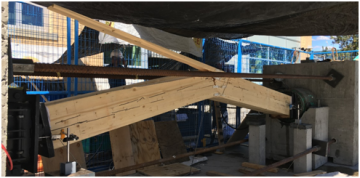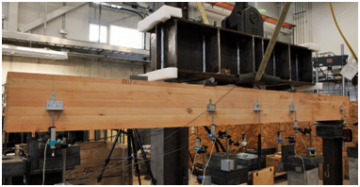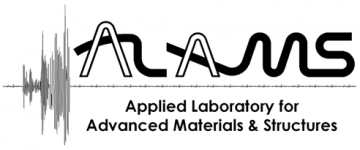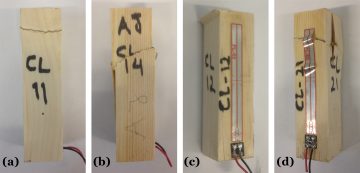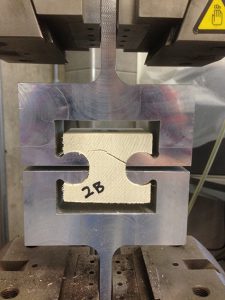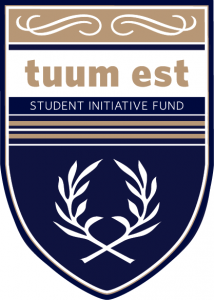Research Project Title: Novel glulam timber column
Research Abstract:
Timber serves as a structural material that possesses a high strength to weight ratio along with a pleasing and aesthetic appearance; consequently, timber is a commonly used construction material in North America. Timber inherently possesses a high level of material variability, which presents an obstacle for its applications in structures. Consequently, numerous solutions were proposed through engineered wood products like glued laminated timber, cross-laminated timber, oriented strand board, and laminated veneer lumber. The material variability can be overcome by cutting the log into pieces, then realign and glue them to form the desired section so that a desirable material strength and stiffness can be obtained. For example, the glued laminated timber, also called glulam, is a type of structural wood product consisting of numerous layers of dimensioned lumber bonded together by a durable, moisture resistant structural adhesive. As a result, the glulam has a good performance and has been heavily used in the construction sector.
Dr Alam’s research group is cooperating with local industries for experimentally evaluating the structural performance of novel timber elements, e.g., new types of glulam column and dowel-laminated timber panels. In 2017, a new type of SPF glulam column and a type of conventional timber column were experimentally tested for evaluating their bending and compression performance. Preliminary design guidelines were provided based on the experimental results, and a pattern will be applied for this new timber product.
Project Team:
[1] M. Shahria Alam
[2] Peng Zhang
[3] Tawsif Mohammad
Publications:
[1] Zhang, Peng, and M. Shahria Alam. ” Experimental Investigation of Regular and Composite Glulam Columns under Flexural and Axial Compression Load.” A project report to Structurlam Ltd, 2018.
Collaborators:
Research Project Title: Performance Evaluation of Composite Timber I-joists with Web Openings and Flange Notches
Research Abstract:
Timber I-joists are composite beams mainly used to support roof and floor panels. They consist of oriented strand board (OSB) webs and timber flanges. For post-construction purposes, these beams are often drilled in the web or notched through the flange in order to pass electrical and mechanical facilities through. This can result in a significantly lower load-carrying capacity for these important elements. Moein’s study investigates the performance of I-joists with web holes and flange notches through experimental and numerical approaches. His study presents the results of experimental investigations on wood for structural purposes, research on load-carrying capacity of full-scale I-joists with different web hole and flange notch configurations, as well as finite element study of timber I-joists for further evaluation. In his study, numerous timber specimens are tested in tension and compression in the three major directions: parallel-to-grain, perpendicular-to-grain radial, and perpendicular-to-grain tangential. Furthermore, several full-size timber I-joists with different opening configurations are also physically tested and the results are processed to extract the structural behavior of the I-beams. The research is expanded using finite element approach to further evaluate the performance of such beams in structural systems. Moein’s research has highlighted the importance of the existence of openings in timber I-joists.
His research led to proposing a finite element approach that can effectively capture the true behavior of timber elements as part of a structure. As well, this research has put forward recommendations for using I-joists with openings, along with effective performance-based design procedures for such beams individually or in a group.
Project Team:
[1] M. Shahria Alam(PI)
[2] Abbas S. Milani(Co-PI)
[3] Rudolf Seethaler(Co-PI)
[4] Moein Ahmadipour
[5] M. Shahidul Islam
[6] Md Shahnewaz
Publications:
Shahnewaz M, Islam MS, Ahmadipour M, Tannert T, Alam MS. Reinforced Wood I-Joists with Web Openings. J Struct Eng (United States) 2017;143. doi:10.1061/(ASCE)ST.1943-
Ahmadipour M, Alam MS. Finite Element modeling of timber I-Joists with web holes and flange notches. 2017 Can. Soc. Civ. Eng. Annu. Conf. (CSCE 2017), Vancouver, BC, Canada: 2017.
Ahmadipour M, Sasibut S, Alam MS. S-TIMBER: Integrated Timber Design by S-FRAME Software. 2018 Can. Soc. Civ. Eng. Annu. Conf. (CSCE 2018), Feredricton, NB, Canada: 2018.
Ahmadipour M, Sasibut S, Alam MS. Integrated Timber Design (ITD) in S-FRAME Software. 2017 Can. Soc. Civ. Eng. Annu. Conf. (CSCE 2017), Vancouver, BC, Canada: 2017.
Collaborators:

